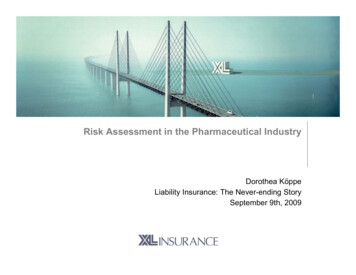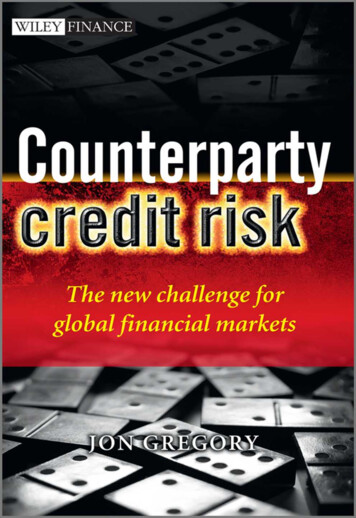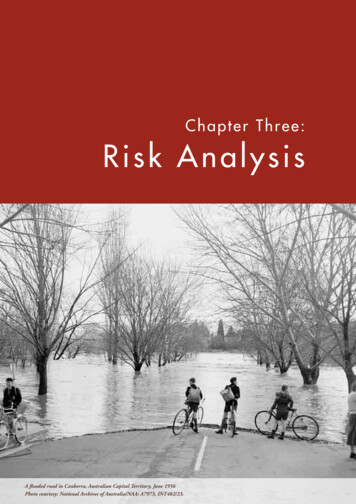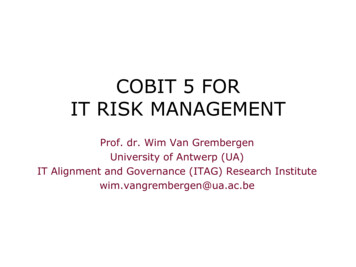
Transcription
Introduction to Risk AnalysisChesapeake AIHA/ASSE Educational SeminarMarch 13, 2013Charles Yoe, Ph.D.cyoe1@verizon.net
Risk Analysis and IndustrialHygiene “Risk analysis methods and tools areimportant resources for articulating scientificknowledge to those who make decisionsregarding public and occupational health.”Synergist April, 2012 “Risk analysis is a framework for decisionmaking under uncertainty.”Me March, 2013
The PointRiskManaging Risk
Risk Assessment Safety Assessment The public wants safety Safety is a subjective determination– Chemicals used underreasonably foreseeableconditions should notadversely affect humans andthe environment– Someone must decide whatsafe is– Subjective decisions rarely satisfyeveryone Risk is a more objective conceptRiskmore/lessSafetyyes/no
OEL NOEL/Safety Factor x BreathingRateSafety Factor 10 x 10Breathing Rate 10 m3 8-hr shiftDaily exposures belowOEL are safe ?Daily exposure aboveOEL are not safe ?Is it more likely yes/no or more/less?0.005 OEL5 NOELµ g/day Charles Yoe, Ph.D.
Risk Risk is a measure of the probability andconsequence of uncertain future events– Risk Probability x Consequence In industrial hygiene– Risk Likelihood x SeverityToxicity/adverse effects on humans, environmentor other endpointsExposure e(frequency, duration, magnitude, pathway/route)
“Flavors” of Risk Risk includes– Exposure to losses (hazards) Risk managers avoid risks– Potential for gain (opportunities) Risk managers take risks
Uncertainty Leads To RiskMacro-Level (Values) Increasing social complexity Rapidly increasing pace ofchange Global effectsMicro-Level (Facts) Knowledge uncertainty Natural variabilityUncertaintyAhead
Micro-Level ios &TheoryIndexvariableThings we UncertaintyThings we nstantsEmpiricalquantities
Risk Analysis- Decision-MakingUnder UncertaintyRisk AssessmentRisk Management Analytically based Policy and preferencebasedRisk Communication Interactive exchange of information, opinions,and preferences concerning risks
Why Use Risk Analysis? To protect human, life andhealth as well as otherendpoints To ensure a more reliableflow of workplace outputsand therefore desirableoutcomes To improve decision makingunder uncertainty Traditional standards basedapproaches are no longerenough—problems persist National and globalcommunities are embracingrisk analysis
Risk Management What is the problem? What questions do wewant risk assessment toanswer? What can be done toreduce the impact ofthe risk described? What can be done toreduce the likelihood ofthe risk described? What are the trade-offsof the availableoptions? What is the best way toaddress the described ? Is it working?
The Risk Manager’s Job! Risk managers are responsible for riskanalysis; they identify or validate problems Risk managers need scientific informationto make decisions under uncertainty– They ask questions, which when answeredyield the information needed to makedecisions
The Risk Manager’s Job! Risk assessors answer the questions andcharacterize the uncertainty in their answers Risk managers mitigate risks that are notacceptable and take risks that are prudent Risk managers make sure that riskcommunication takes place
Risk Management ProcessProblemIdentification1. Problemrecognition2.Problem acceptance3. Problem definitionRisk Monitoring1. Monitoring2. EvaluationRisk Estimation1. Establish riskanalysis process2.Individual riskmanagementactivities3. IterationRisk Control1.Formulating RMO’sRisk Evaluation2.Evaluationg RMO’s1. Principles forestablishingacceptable risks andtolerable levels of risk3. Comparing RMO’s4.Choosing an RMO5. ID decisionoutcomes6. Implement decision2. The decision
Who Are the Risk Managers? OSHA? State? Company? Workers? There need to be many risk managers Who “owns” what part of the risk?
Risk Management StrategiesRisk Management StrategiesAccept the risk as is?Risk ReductionRisk TakingRisk AvoidanceRisk CreationRisk PreventionRisk StimulationRisk MitigationRisk PromotionRisk TransferRisk SharingRisk RetentionRisk Ignoring
Risk Assessment What can go wrong?How can it happen?How likely is it?What are the consequences?
Risk Assessment ModelAn analytical and scientifically based process consisting of the following steps:Look for the Hazard or OpportunityIdentify the hazards that can cause harm or theopportunities for gain that are uncertain.Consequence AssessmentDecide who or what may be harmed or benefited and in whatways. Gather and analyze the relevant data. Characterize theconsequences and their uncertainty qualitatively or quantitatively.Likelihood AssessmentAssess the likelihood of the various adverse and beneficialconsequences. Characterize these likelihoods and theiruncertainty qualitatively or quantitatively.Risk CharacterizationEstimate the probability of occurrence, the severity ofadverse consequences, and the magnitude of potentialgains, including attendant uncertainties, of the hazards andopportunities identified based on the evidence in thepreceding steps. Characterize the risk qualitatively orquantitatively with appropriate attention to baseline andresidual risks, risk reductions, transformations and transfers.
EPA (Toxic Air Pollutants)
Qualitative Risk Assessment MethodsToolbox Increase or DecreaseRisk Risk Narratives Evidence Mapping Screening Ratings Rankings Enhanced CriteriaRanking Operational RiskManagement (RiskMatrix) Develop a GenericProcess Qualitative AssessmentModels Multi-Criteria DecisionAnalysis
Quantitative Risk Assessment Safety Assessment Scenario Planning Scenario Analysis– Deterministic Scenario Analysis– Probabilistic Scenario Analysis Sensitivity AnalysisUncertainty AnalysisModelingVulnerability Assessment
Risk Communication Why are we communicating?Who is our audience?What do our audiences want to know?What do we want to get across?How will we communicate?How will we listen?How will we respond?
Risk Communication Goals Tailor communication so it takes into account theemotional response to an event. Empowers stakeholders and public to makeinformed decisions. Prevent negative behavior and/or encourageconstructive responses to crisis or danger.
Scientist - Consumer feelsbelievesFact-based:hazard, probabilityValue-based:consequences, value
Goal: Reduce outrage so people don’t takeunnecessary tCrisis /EmergencyCommunicationPublicRelationsLowHazard (danger)PrecautionAdvocacyHigh
Goal: Increase concern for a real hazard to motivatepreventive is nAdvocacyHighHazard (danger)
Goal: Acknowledge hazard, validate concern, givepeople ways to elationsCrisis zard (danger)
Take Away Points Risk analysis comprises three tasks—riskassessment, risk management, and riskcommunication Risk management is decision making underuncertainty that depends on– Science & values important to stakeholders Risk assessment is evidence gathering– Separates what we know from what we don’t know Risk communication will vary with thecircumstances of the risk
Risk Management Process Problem Identification 1. Problem recognition 2.Problem acceptance 3. Problem definition Risk Estimation 1. Establish risk analysis process 2.Individual risk management activities Risk Evaluation 1. Principles for establishing acceptable risks and tolerable levels of risk 2. The decision Risk Control 1.Formulating RMO's










